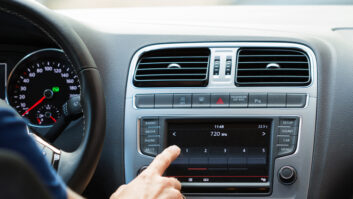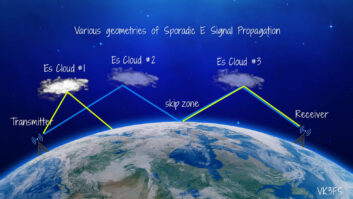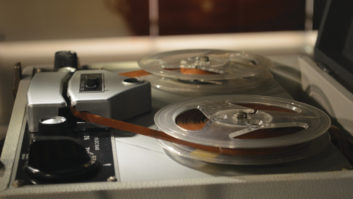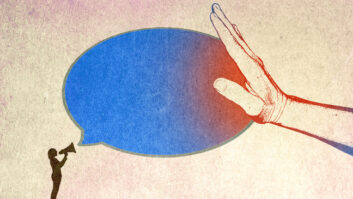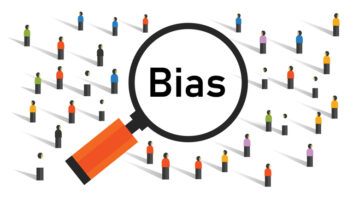Not Ready for Prime Time
I just read Gary Shapiro’s one-sided, inflammatory and somewhat threatening commentary “Say No to Buggy-Whip Technology Mandates” (Nov. 17).
He calls FM radio “all but obsolete” and claims that 70 percent of cellphone and smartphone owners aren’t interested in having FM capability in their phones. Assuming his numbers are accurate, that means almost 30 percent are interested; and I’d be willing to bet the number would be significantly higher if those owners were simply asked if they wanted access to more entertainment and information options on their phones for free, which is what FM radio provides.
Shapiro says FM is obsolete. I say his supposedly consumer-driven alternatives aren’t ready for prime time.
I live in an affluent, densely populated suburb of Houston and have to rely on a femtocell to make sure my iPhone 4 operates semi-reliably at home. At my gym, a few miles north of home, I am unable to get cellular data with the speed or stability necessary to utilize any form of streaming entertainment.
Wanna know what does work well at my gym? FM radio. I even listen to the talk radio programming I can’t get on my signal-hobbled iPhone, via a few HD3 channels on a pocket HD Radio.
Put aside the NAB’s public safety argument for FM tuner inclusion. Let’s talk basic, live entertainment. My iPhone simply can’t deliver it reliably. Well, it can’t as of today anyway, because Apple hasn’t yet given users access to the FM tuner already embedded in every iPhone.
In October 2009, PCWorld.com, among several sites, reported that Apple was very close to releasing an app that would allow iPhone users to access their FM tuners. Over a year later, it still hasn’t happened.
If 30 percent of smartphone users want an FM tuner, why won’t Apple release the app? Could it be that Mr. Shapiro and his colleagues are only interested in “consumer demand” when it doesn’t tread on CEA member profitability? Would someone being entertained for free by an FM radio app in their smartphone be more or less likely to purchase content from manufacturer portals like the iTunes store? If it’s not about money, where’s the iPhone FM tuner app? I doubt user interest in any app, short of e-mail and Web browsing, is 30 percent.
It seems to me it’s less a matter of FM being obsolete than of certain manufacturers propping up their own revenue streams through monopolistic practices. That is something Congress should consider.
Robbie Green
Chief Engineer
KRBE(FM)/KHJK(FM)/KFNC(FM)
Houston, Texas
This Calls for an Apology
Gary Shapiro said broadcasters’ strategy “is a cynical ploy to distract lawmakers from the burning question of whether radio broadcasters should continue to enjoy their exemption from performance royalty payments.”
Does the CEA have to pay 8 percent off the top of their gross revenues every year for the privilege of promoting someone else’s products? For many decades broadcasters have paid an average of 8 percent of their gross revenues to ASCAP, BMI and SESAC, the owners of the copyrights on music. Many times the performers are also the composers, and often they also have their own publishing houses, so they get revenue every quarter of the year. And they do get some very sizable payments.
For an example, I had a close friend in the music business who’d been part of the Duke Ellington organization. He wound up owning the Ellington library. One day at his office he showed me his ASCAP check for over $300,000. That was his quarterly payment from ASCAP … after they deducted their operating fees. And this was just about five years ago.
Bet you would not think Duke Ellington compositions and arrangements would generate that much airplay worldwide to make that much income for his works, most of which were done back in the 1930s and ’40s.
Radio, TV, networks, movies, all of us pay royalties every month to ASCAP, BMI and SESAC. And we provide free use of our stations for the general public to hear that music, often for the first time.
Gary Shapiro also stated: “Many local radio stations are unmanned, particularly at nights and on weekends, rendering the alleged emergency alert ‘benefit’ unreliable and raising questions about the wisdom of permitting such unattended operation.”
These statements tell me Mr. Shapiro does not really know much about the radio industry.
We are required to have EAS equipment monitoring three separate radio sources, usually a primary FM signal, a secondary FM signal and a NOAA weather signal. This equipment must interrupt the program line and transmit any alerts. Just today we had weekly test and a monthly test received from our state emergency operations center; they were each immediately broadcast over our stations.
We also originated our own weekly test within the required time limits. We are also one of about 70 Florida high-power FMs selected by the state EOC to have the new viaRadio HEARO Emergency Alert System installed. It sends alerts to HEARO radios and also interrupts our RDS display and sends the text message of the alerts.
Earlier this week we had severe thunderstorm and tornado watch alerts going out audibly on our stations and visually over our RDS display.
No one had to touch a single piece of equipment or be here to switch anything for that to happen.
When an FCC inspector visits a station, the first things they usually ask to see are the EAS equipment and the logs. The broadcasters must purchase expensive EAS equipment; very soon we are going to have to throw away our current-generation EAS controllers and purchase new units to meet the newest standards. And if it is not working when the FCC inspector visits, there is usually a citation and a fine.
Mr. Shapiro, you owe the radio broadcasters a big apology.
Cal Zethmayr
General Sales Manager
WAAZ(FM)/WJSB(AM)
Crestview, Fla.
Off-Air Reception Is Proven
I found four flaws in Mr. Shapiro’s reasoning for not embedding FM receivers into cellphones.
First, a cellphone is a radio, so what’s wrong with incorporating an actual FM radio inside?
Second, most cellular subscribers are not tech-savvy, so why would they even care whether the broadcasts are obtained off-air or via digital streaming?
Third, in a disaster (like Katrina), the Internet, and particularly WiFi hot spots, probably will be inoperative. AM and FM broadcast, in contrast, most likely will remain on the air. Thus, receiving anything via the Internet or a cellular network is a bad idea.
Last, what if your favorite FM station does not participate in program streaming? This technology is expensive and has certain copyright issues. A lot of stations do not provide this service.
Mr. Shapiro’s characterization that this is “buggy-whipping” may be debatable. The benefits of off-air reception are not.
Better yet, incorporate an EAS monitoring feature into the cellphone so that you can program your local LP1 frequency into the phone and have a built-in EAS decoder to get your attention. (I want the patent on this if it becomes reality!)
H. Robert Schroeder, N2HX
Communications and Warning Officer
New Jersey Office of Emergency Management
Trenton, N.J.
The Wired Backbone Is Vulnerable
Gary Shapiro makes his case by saying you can do it all via the cellphone and Internet now.
Yes … until cell circuits, phone circuits and Internet are out, as they were after the 1989 California Loma Prieta earthquake; in parts of New York City after 9/11; and in New Orleans after Hurricane Katrina in 2005. And as they often are when wires are down due to a storm in your area or when a fiber line is damaged.
The Internet and cellphone have a “wired backbone” that is easily overloaded or broken in disasters. Old-fashioned radio was there during these disasters — simple radio (and TV) broadcasting from stations that have generators and a real desire to serve the public.
A simple battery-operated radio or TV — or a cellphone with receiver built in, designed to use low power in the radio/TV receive-only mode, not mandated but optional — will be there for you when the cell circuits are down.
Do you know of a PC, laptop, cellphone or other device that uses Internet circuits and will work on two or four AA batteries for up to 20 hours or more? A simple, cheap radio will.
One thing I agree with Mr. Shapiro on: Unmanned radio stations usually let you down during a disaster, unlike a station that has “real people” on duty all the time. This could be the difference in knowing what is going on vs. hearing Elton John’s “Rocket Man” while the real rockets might be coming.
I don’t think radio should be forced into every cellphone. But people need to know that their cellphone, iPads and any other device using the Internet will not be there all the time for you, especially in a disaster. Too many people are led to believe that the cellphone, Internet devices and things that are “digital” are a panacea. They are not. I’d take old-fashioned over-the-air radio any day in a disaster.
Al Tobia
Northern California
Chasing Interference
I’ve been enjoying the articles in your publication so much this past year that I’ve stopped passing the magazine on to other guys in the shop so that I can hang on to them. The stories “Armstrong Wasn’t the Only One” and “Interference: Define and Conquer” in the Sept. 8 issue are just two examples of archival interest.
I’m sure the latter story by Tom Osenkowsky generated replies. While I was employed as chief operator for KZOZ(FM) in San Luis Obispo, Calif., we received a complaint of interference on one of the control tower frequencies at the county airport. We were also contacted by the local CATV provider, which had an operating plant collocated near our transmitter building. They complained that our signal was getting in and causing visual noise on Channel 3.
First task was to put a dummy load on the transmitter and look for the spur, but we came up empty. The transmitter was clean.
Next we had someone climb the KSBY(TV) tower, where our antenna was located about halfway up, and check for loose hardware. Still nothing.
We contacted the FCC and FAA and requested assistance. The FCC field office dispatched their mobile van, loaded with racks of instruments.
Directional sniffing from a nearby peak confirmed the spur was being generated from the transmitter site. And sniffing around at the site confirmed a stronger spur, but it seemed to be in every direction.
The FCC engineer then had us walk the entire site and put our hand on any exposed metal on the ground or in the air. After several minutes the FCC engineer yelled out, “What did you do? The signal disappeared for a second.”
At that point I was on the roof of the CATV building and had steadied my balance by grabbing a length of pipe where a VHF antenna had been mounted by the CATV operators. A rusty hose clamp was the culprit.
From then on I had newfound respect for the FCC and FAA.
Jan Lipski
Lompoc, Calif.
Share tales of your own interference-fighting adventures by e-mailing to [email protected].
Alone With the Transmitter in 1942
I enjoyed John Schneider’s article “A Workplace for the Radio Gods” (Nov. 17).
What caught my eye was the great picture of that WE transmitter. It was the same model as the one I worked in front of at KFBB in Great Falls, Mont., my second stop on my way to the West Coast, late spring of 1942.
The KFBB layout was straight along the wall like WWJ’s, with the door on the right taking you out along a wire fence protecting the high-voltage parts. Next to a door allowing entry into the fenced area was a large switch and its associated key system. To access any door in the system, you had to turn off the big switch and then extract the key you needed.
On Sunday afternoons when I was on duty, during the “Old Fashioned Revival Hour” with Rev. Charles E. Fuller, there would be a lightning strike along the line, usually miles away; the fuse in the small rectifier cabinet would blow. It would take three minutes to shut down the transmitter, extract the key and then go out in front and open the door to the locked rectifier cabinet, replace the fuse and then time-cycle the transmitter back on again.
This would usually happen two times during the “Old Fashioned Revival Hour.” Not before, not after.
At KFBB there was a console in front of the transmitter, along with three big 16-inch turntables. Being water-cooled, it was quiet. My shift normally was Monday to Friday, 6 a.m. to noon. I would stop by the studio in town about 5:30 a.m., pick up a large case of 16-inch and smaller transcriptions and my copy for the morning, and put it in the rumble seat of my Model A, then head for the transmitter about four miles out of town on the highway to Glacier Park. I would get there about 10 minutes to 6, time to warm up the transmitter for a 6 a.m. sign-on.
All morning we would run some of those great shows: George and Gracie, Burl Ives, Kate Smith and Ted Collins, all 15-minute shows. The soap operas were on the transcriptions I brought out; the episode for the day was on the big disc, with the lead-ins and commercials on a smaller disc. It was my job to make it sound live. In between I would switch to the main studio for local news, farm reports, etc.
As I look back it was a great experience. What fun for an 18-year-old kid with a brand-new license.
At noon I would head into town and write copy all afternoon under the guidance of a copy editor who had worked at the Star Journal back in Minneapolis. I guess that is where my “learn by doing” philosophy developed.
Thanks again for stirring up my memory bank.
Paul Gregg
President
Bauer Transmitters Inc.
El Paso, Texas

